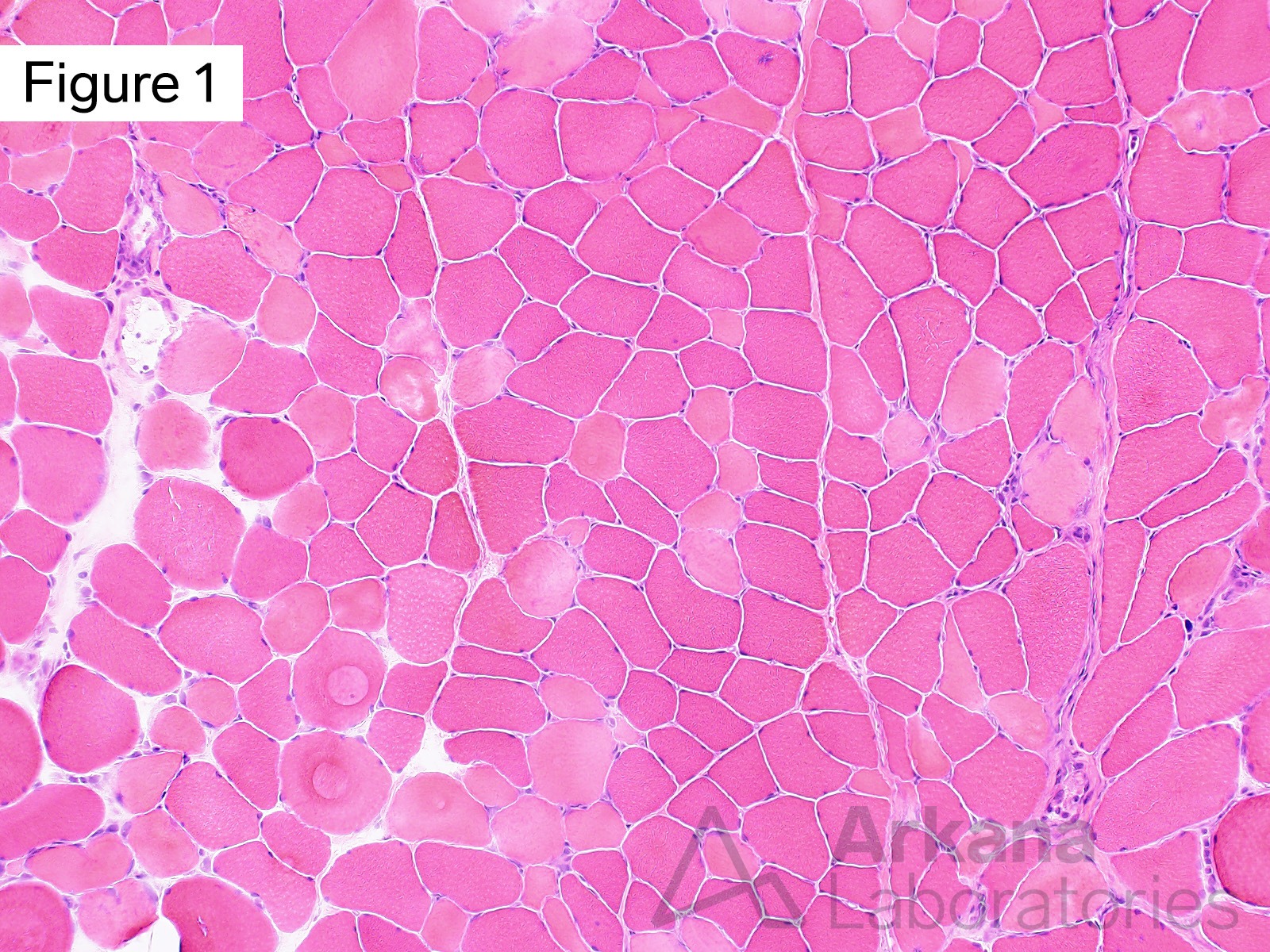
This 35-year-old previously healthy patient developed generalized myalgias, muscle weakness, and dark colored urine the day after eating cooked fish while on holiday in the South Americas. They returned home to the United States. Laboratory studies showed significant elevation of CPK (>20000) and myoglobin. Myositis specific autoantibody panel (including SRP) and HMGCR autoantibody testing were negative. The patient was not taking any outpatient medications and toxin screen was negative.
Based on the clinical history and abnormalities demonstrated in Figures #1 – #3 which of the following is most likely?
A. Toxic myopathy
B. Dermatomyositis
C. Anti-synthetase syndrome
D. Polymyositis
Correct Answer: Toxic myopathy
The morphologic alterations alone are not specific as to etiology as they may be seen in a variety of clinical contexts. This highlights the necessity of clinicopathologic correlation in neuromuscular pathology. In the setting of this patient’s clinical history the pathologic changes are most consistent with toxic myopathy due to ingestion of palytoxin (PTX) containing fish (Haff disease). Polytoxins are one of the most toxic marine toxins known and are present in soft corals and dinoflagellates. Please see references below.
Reference(s) / additional reading:
Almeida LKR, Gushken F, Abregu-Diaz DR, Muniz R Jr, Degani-Costa LH. Rhabdomyolysis following fish consumption: a contained outbreak of Haff Disease in São Paulo. Braz J Infect Dis. 2019 Jul-Aug;23(4):278-280. doi: 10.1016/j.bjid.2019.06.011. Epub 2019 Jul 24. PMID: 31351034.
Bandeira AC, Campos GS, Ribeiro GS, Cardoso CW, Bastos CJ, Pessoa TL, Araujo KA, Grassi MFR, Castro AP, Carvalho RH, Prates APPB, Gois LL, Rocha VF, Sardi SI. Clinical and laboratory evidence of Haff disease – case series from an outbreak in Salvador, Brazil, December 2016 to April 2017. Euro Surveill. 2017 Jun 15;22(24):30552. doi: 10.2807/1560-7917.ES.2017.22.24.30552. PMID: 28661391; PMCID: PMC5479974.
Cardoso CW, et al. Haff Disease in Salvador, Brazil, 2016-2021: Attack rate and detection of toxin in fish samples collected during outbreaks and disease surveillance. The Lancet Region Health – Americas 2021;00: 100092: https//doi.org/10.1016/j.lana.2021.100092
Centers for Disease Control and Prevention (CDC). Haff disease associated with eating buffalo fish–United States, 1997. MMWR Morb Mortal Wkly Rep. 1998 Dec 25;47(50):1091-3. PMID: 9883771.
Centers for Disease Control and Prevention (CDC). Haff disease associated with eating buffalo fish–United States, 1997. MMWR Morb Mortal Wkly Rep. 1998 Dec 25;47(50):1091-3. PMID: 9883771.
Diaz JH. Global incidence of rhabdomyolysis after cooked seafood consumption (Haff disease). Clin Toxicol (Phila). 2015 Jun;53(5):421-6. doi: 10.3109/15563650.2015.1016165. Epub 2015 Mar 19. PMID: 25789572.
Sud P, Su MK, Greller HA, Majlesi N, Gupta A. Case series: inhaled coral vapor–toxicity in a tank. J Med Toxicol. 2013 Sep;9(3):282-6. doi: 10.1007/s13181-013-0307-x. PMID: 23702624; PMCID: PMC3770997.
Quick note: This post is to be used for informational purposes only and does not constitute medical or health advice. Each person should consult their own doctor with respect to matters referenced. Arkana Laboratories assumes no liability for actions taken in reliance upon the information contained herein.


